Business Law - General Partnership
VerifiedAdded on 2023/04/25
|6
|1533
|137
AI Summary
This document discusses the legal liability of partners in a general partnership. It covers scenarios such as entering into a contract without consent, accidental damage caused by a partner, misapplication of funds, profit sharing ratio, and personal business. The document also explains the fiduciary duty of partners and the joint liability of all partners in a general partnership.
Contribute Materials
Your contribution can guide someone’s learning journey. Share your
documents today.
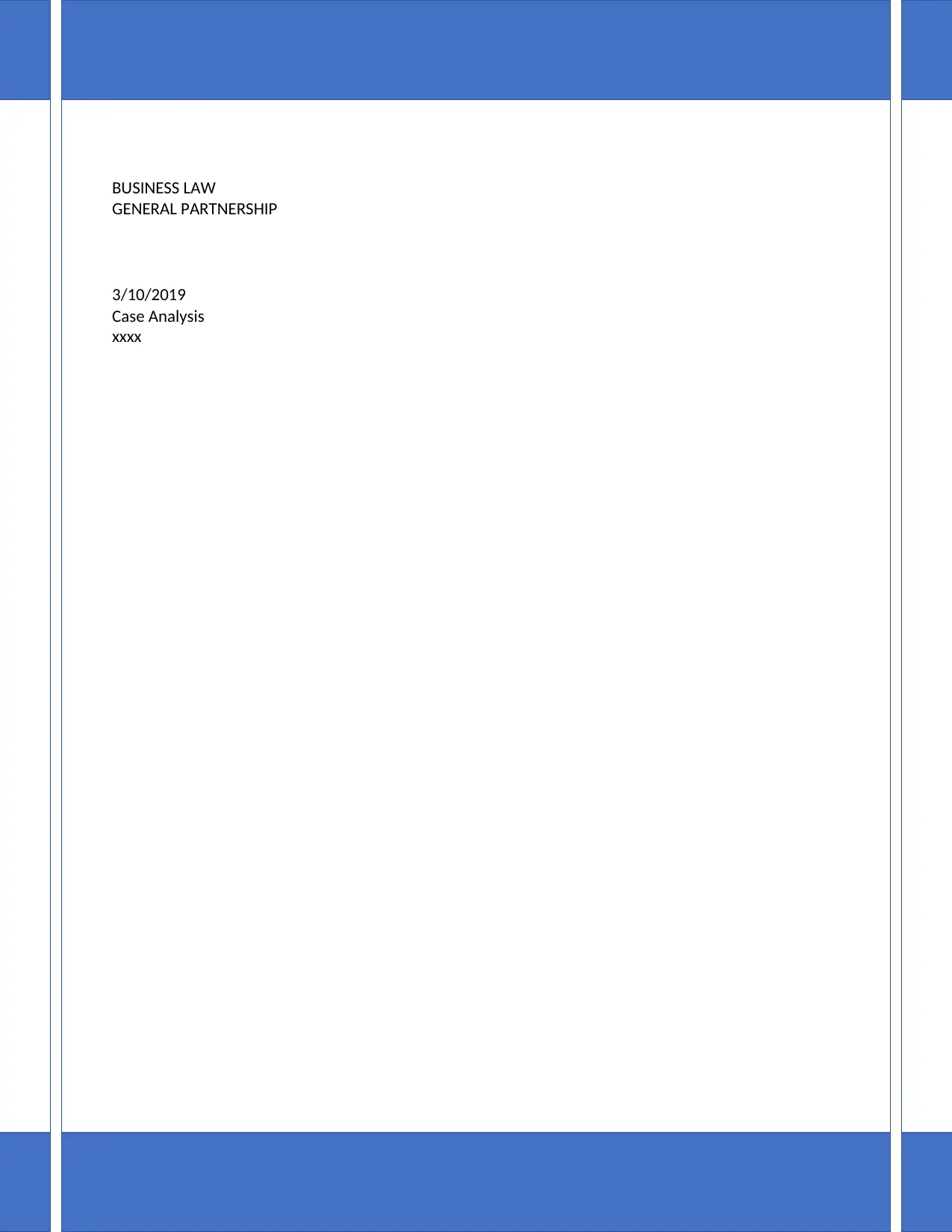
BUSINESS LAW
GENERAL PARTNERSHIP
3/10/2019
Case Analysis
xxxx
GENERAL PARTNERSHIP
3/10/2019
Case Analysis
xxxx
Secure Best Marks with AI Grader
Need help grading? Try our AI Grader for instant feedback on your assignments.
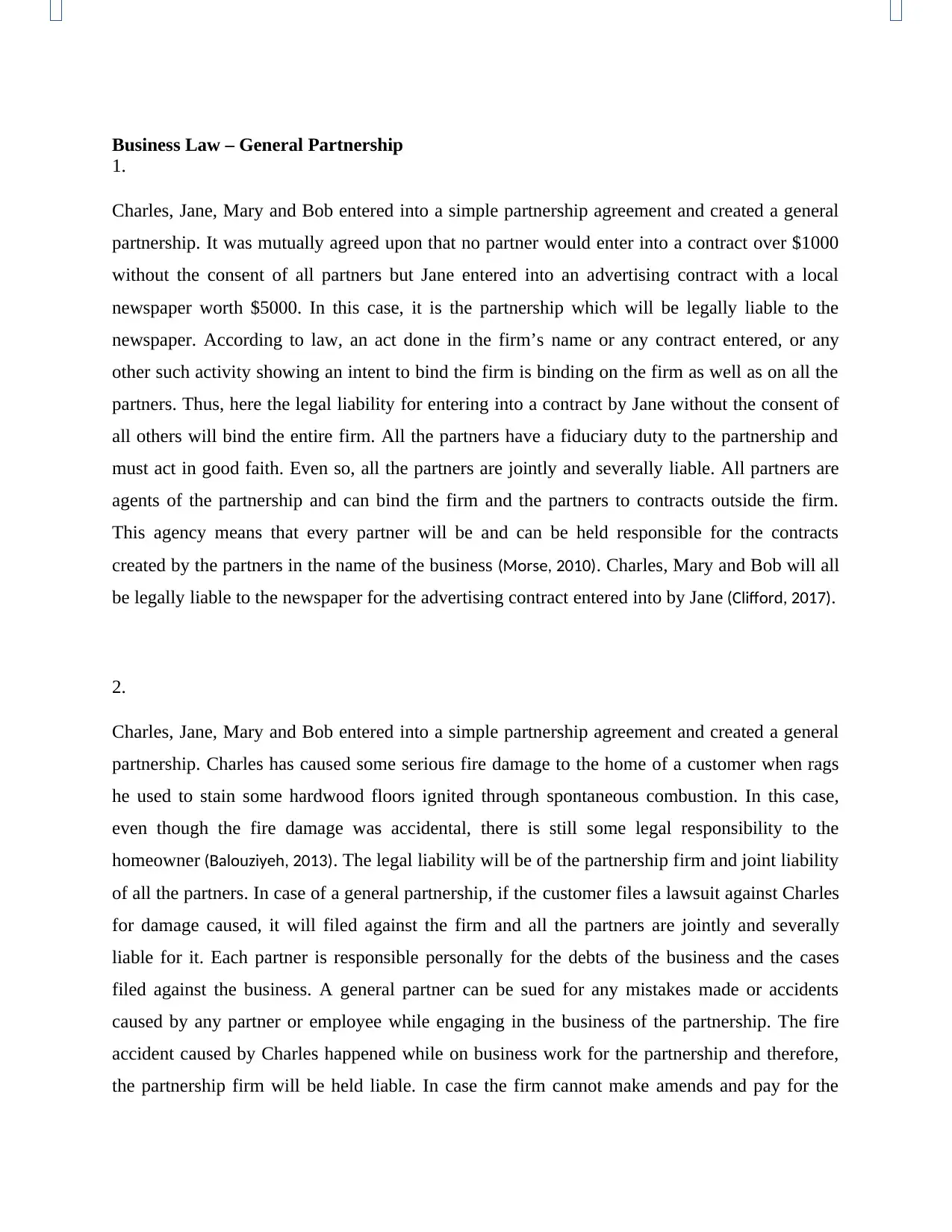
Business Law – General Partnership
1.
Charles, Jane, Mary and Bob entered into a simple partnership agreement and created a general
partnership. It was mutually agreed upon that no partner would enter into a contract over $1000
without the consent of all partners but Jane entered into an advertising contract with a local
newspaper worth $5000. In this case, it is the partnership which will be legally liable to the
newspaper. According to law, an act done in the firm’s name or any contract entered, or any
other such activity showing an intent to bind the firm is binding on the firm as well as on all the
partners. Thus, here the legal liability for entering into a contract by Jane without the consent of
all others will bind the entire firm. All the partners have a fiduciary duty to the partnership and
must act in good faith. Even so, all the partners are jointly and severally liable. All partners are
agents of the partnership and can bind the firm and the partners to contracts outside the firm.
This agency means that every partner will be and can be held responsible for the contracts
created by the partners in the name of the business (Morse, 2010). Charles, Mary and Bob will all
be legally liable to the newspaper for the advertising contract entered into by Jane (Clifford, 2017).
2.
Charles, Jane, Mary and Bob entered into a simple partnership agreement and created a general
partnership. Charles has caused some serious fire damage to the home of a customer when rags
he used to stain some hardwood floors ignited through spontaneous combustion. In this case,
even though the fire damage was accidental, there is still some legal responsibility to the
homeowner (Balouziyeh, 2013). The legal liability will be of the partnership firm and joint liability
of all the partners. In case of a general partnership, if the customer files a lawsuit against Charles
for damage caused, it will filed against the firm and all the partners are jointly and severally
liable for it. Each partner is responsible personally for the debts of the business and the cases
filed against the business. A general partner can be sued for any mistakes made or accidents
caused by any partner or employee while engaging in the business of the partnership. The fire
accident caused by Charles happened while on business work for the partnership and therefore,
the partnership firm will be held liable. In case the firm cannot make amends and pay for the
1.
Charles, Jane, Mary and Bob entered into a simple partnership agreement and created a general
partnership. It was mutually agreed upon that no partner would enter into a contract over $1000
without the consent of all partners but Jane entered into an advertising contract with a local
newspaper worth $5000. In this case, it is the partnership which will be legally liable to the
newspaper. According to law, an act done in the firm’s name or any contract entered, or any
other such activity showing an intent to bind the firm is binding on the firm as well as on all the
partners. Thus, here the legal liability for entering into a contract by Jane without the consent of
all others will bind the entire firm. All the partners have a fiduciary duty to the partnership and
must act in good faith. Even so, all the partners are jointly and severally liable. All partners are
agents of the partnership and can bind the firm and the partners to contracts outside the firm.
This agency means that every partner will be and can be held responsible for the contracts
created by the partners in the name of the business (Morse, 2010). Charles, Mary and Bob will all
be legally liable to the newspaper for the advertising contract entered into by Jane (Clifford, 2017).
2.
Charles, Jane, Mary and Bob entered into a simple partnership agreement and created a general
partnership. Charles has caused some serious fire damage to the home of a customer when rags
he used to stain some hardwood floors ignited through spontaneous combustion. In this case,
even though the fire damage was accidental, there is still some legal responsibility to the
homeowner (Balouziyeh, 2013). The legal liability will be of the partnership firm and joint liability
of all the partners. In case of a general partnership, if the customer files a lawsuit against Charles
for damage caused, it will filed against the firm and all the partners are jointly and severally
liable for it. Each partner is responsible personally for the debts of the business and the cases
filed against the business. A general partner can be sued for any mistakes made or accidents
caused by any partner or employee while engaging in the business of the partnership. The fire
accident caused by Charles happened while on business work for the partnership and therefore,
the partnership firm will be held liable. In case the firm cannot make amends and pay for the
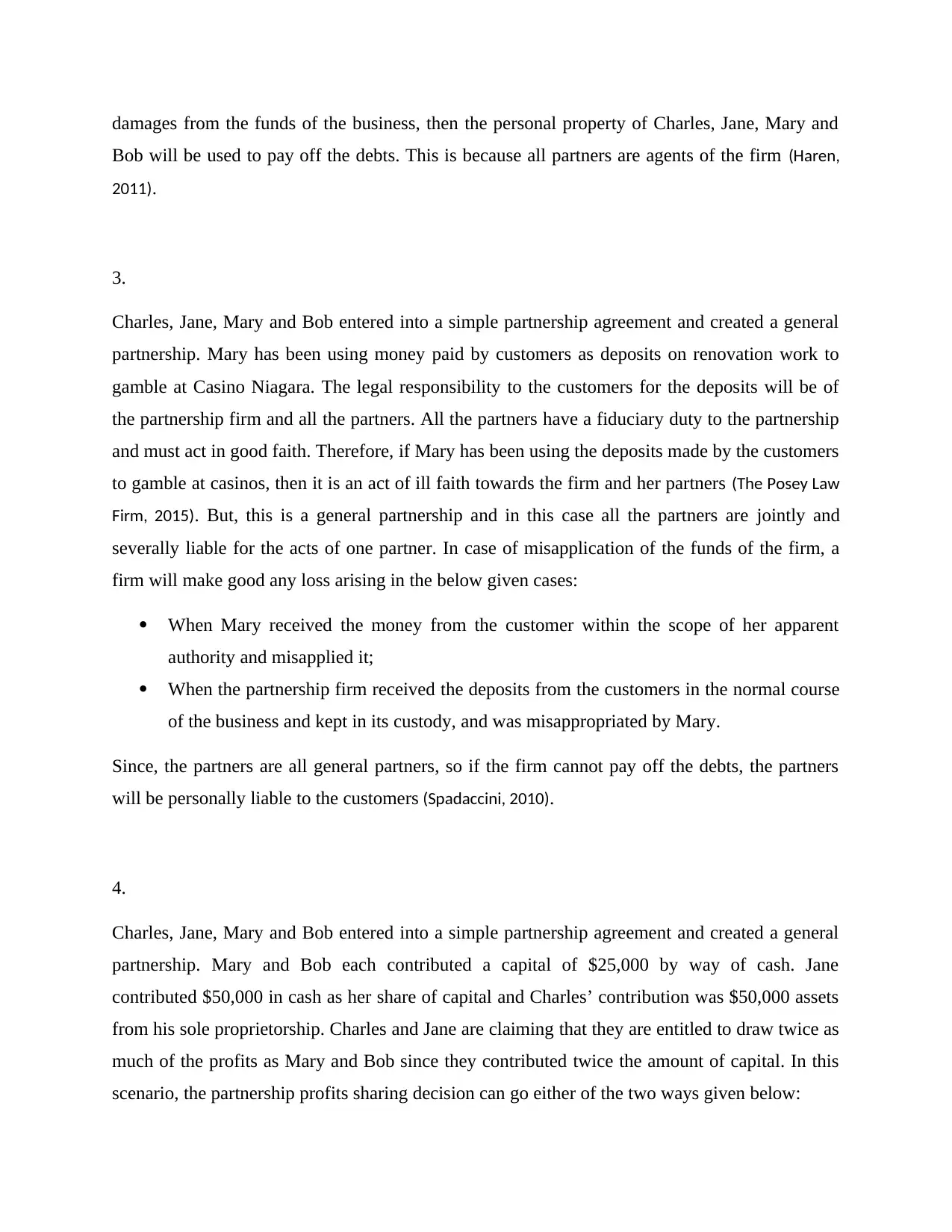
damages from the funds of the business, then the personal property of Charles, Jane, Mary and
Bob will be used to pay off the debts. This is because all partners are agents of the firm (Haren,
2011).
3.
Charles, Jane, Mary and Bob entered into a simple partnership agreement and created a general
partnership. Mary has been using money paid by customers as deposits on renovation work to
gamble at Casino Niagara. The legal responsibility to the customers for the deposits will be of
the partnership firm and all the partners. All the partners have a fiduciary duty to the partnership
and must act in good faith. Therefore, if Mary has been using the deposits made by the customers
to gamble at casinos, then it is an act of ill faith towards the firm and her partners (The Posey Law
Firm, 2015). But, this is a general partnership and in this case all the partners are jointly and
severally liable for the acts of one partner. In case of misapplication of the funds of the firm, a
firm will make good any loss arising in the below given cases:
When Mary received the money from the customer within the scope of her apparent
authority and misapplied it;
When the partnership firm received the deposits from the customers in the normal course
of the business and kept in its custody, and was misappropriated by Mary.
Since, the partners are all general partners, so if the firm cannot pay off the debts, the partners
will be personally liable to the customers (Spadaccini, 2010).
4.
Charles, Jane, Mary and Bob entered into a simple partnership agreement and created a general
partnership. Mary and Bob each contributed a capital of $25,000 by way of cash. Jane
contributed $50,000 in cash as her share of capital and Charles’ contribution was $50,000 assets
from his sole proprietorship. Charles and Jane are claiming that they are entitled to draw twice as
much of the profits as Mary and Bob since they contributed twice the amount of capital. In this
scenario, the partnership profits sharing decision can go either of the two ways given below:
Bob will be used to pay off the debts. This is because all partners are agents of the firm (Haren,
2011).
3.
Charles, Jane, Mary and Bob entered into a simple partnership agreement and created a general
partnership. Mary has been using money paid by customers as deposits on renovation work to
gamble at Casino Niagara. The legal responsibility to the customers for the deposits will be of
the partnership firm and all the partners. All the partners have a fiduciary duty to the partnership
and must act in good faith. Therefore, if Mary has been using the deposits made by the customers
to gamble at casinos, then it is an act of ill faith towards the firm and her partners (The Posey Law
Firm, 2015). But, this is a general partnership and in this case all the partners are jointly and
severally liable for the acts of one partner. In case of misapplication of the funds of the firm, a
firm will make good any loss arising in the below given cases:
When Mary received the money from the customer within the scope of her apparent
authority and misapplied it;
When the partnership firm received the deposits from the customers in the normal course
of the business and kept in its custody, and was misappropriated by Mary.
Since, the partners are all general partners, so if the firm cannot pay off the debts, the partners
will be personally liable to the customers (Spadaccini, 2010).
4.
Charles, Jane, Mary and Bob entered into a simple partnership agreement and created a general
partnership. Mary and Bob each contributed a capital of $25,000 by way of cash. Jane
contributed $50,000 in cash as her share of capital and Charles’ contribution was $50,000 assets
from his sole proprietorship. Charles and Jane are claiming that they are entitled to draw twice as
much of the profits as Mary and Bob since they contributed twice the amount of capital. In this
scenario, the partnership profits sharing decision can go either of the two ways given below:
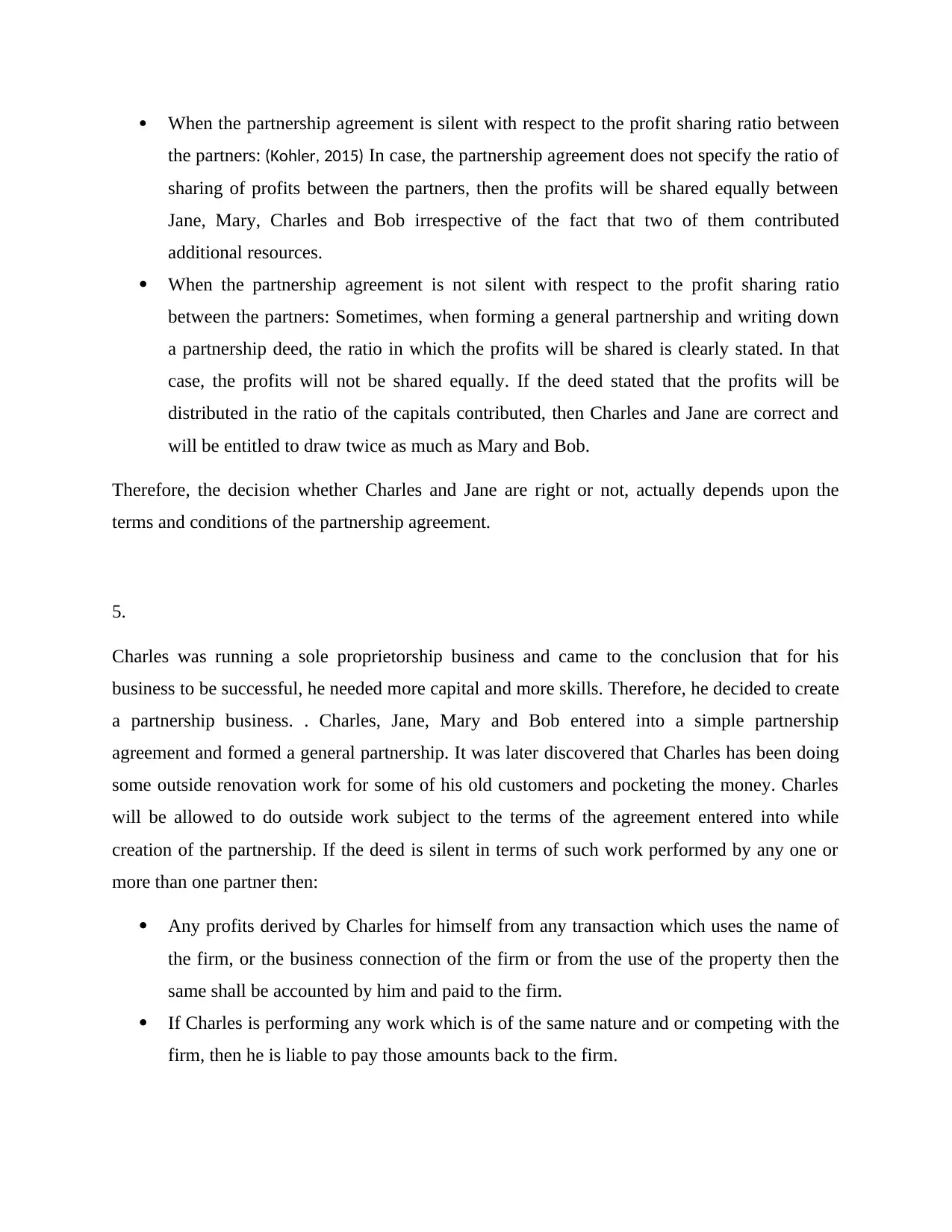
When the partnership agreement is silent with respect to the profit sharing ratio between
the partners: (Kohler, 2015) In case, the partnership agreement does not specify the ratio of
sharing of profits between the partners, then the profits will be shared equally between
Jane, Mary, Charles and Bob irrespective of the fact that two of them contributed
additional resources.
When the partnership agreement is not silent with respect to the profit sharing ratio
between the partners: Sometimes, when forming a general partnership and writing down
a partnership deed, the ratio in which the profits will be shared is clearly stated. In that
case, the profits will not be shared equally. If the deed stated that the profits will be
distributed in the ratio of the capitals contributed, then Charles and Jane are correct and
will be entitled to draw twice as much as Mary and Bob.
Therefore, the decision whether Charles and Jane are right or not, actually depends upon the
terms and conditions of the partnership agreement.
5.
Charles was running a sole proprietorship business and came to the conclusion that for his
business to be successful, he needed more capital and more skills. Therefore, he decided to create
a partnership business. . Charles, Jane, Mary and Bob entered into a simple partnership
agreement and formed a general partnership. It was later discovered that Charles has been doing
some outside renovation work for some of his old customers and pocketing the money. Charles
will be allowed to do outside work subject to the terms of the agreement entered into while
creation of the partnership. If the deed is silent in terms of such work performed by any one or
more than one partner then:
Any profits derived by Charles for himself from any transaction which uses the name of
the firm, or the business connection of the firm or from the use of the property then the
same shall be accounted by him and paid to the firm.
If Charles is performing any work which is of the same nature and or competing with the
firm, then he is liable to pay those amounts back to the firm.
the partners: (Kohler, 2015) In case, the partnership agreement does not specify the ratio of
sharing of profits between the partners, then the profits will be shared equally between
Jane, Mary, Charles and Bob irrespective of the fact that two of them contributed
additional resources.
When the partnership agreement is not silent with respect to the profit sharing ratio
between the partners: Sometimes, when forming a general partnership and writing down
a partnership deed, the ratio in which the profits will be shared is clearly stated. In that
case, the profits will not be shared equally. If the deed stated that the profits will be
distributed in the ratio of the capitals contributed, then Charles and Jane are correct and
will be entitled to draw twice as much as Mary and Bob.
Therefore, the decision whether Charles and Jane are right or not, actually depends upon the
terms and conditions of the partnership agreement.
5.
Charles was running a sole proprietorship business and came to the conclusion that for his
business to be successful, he needed more capital and more skills. Therefore, he decided to create
a partnership business. . Charles, Jane, Mary and Bob entered into a simple partnership
agreement and formed a general partnership. It was later discovered that Charles has been doing
some outside renovation work for some of his old customers and pocketing the money. Charles
will be allowed to do outside work subject to the terms of the agreement entered into while
creation of the partnership. If the deed is silent in terms of such work performed by any one or
more than one partner then:
Any profits derived by Charles for himself from any transaction which uses the name of
the firm, or the business connection of the firm or from the use of the property then the
same shall be accounted by him and paid to the firm.
If Charles is performing any work which is of the same nature and or competing with the
firm, then he is liable to pay those amounts back to the firm.
Secure Best Marks with AI Grader
Need help grading? Try our AI Grader for instant feedback on your assignments.
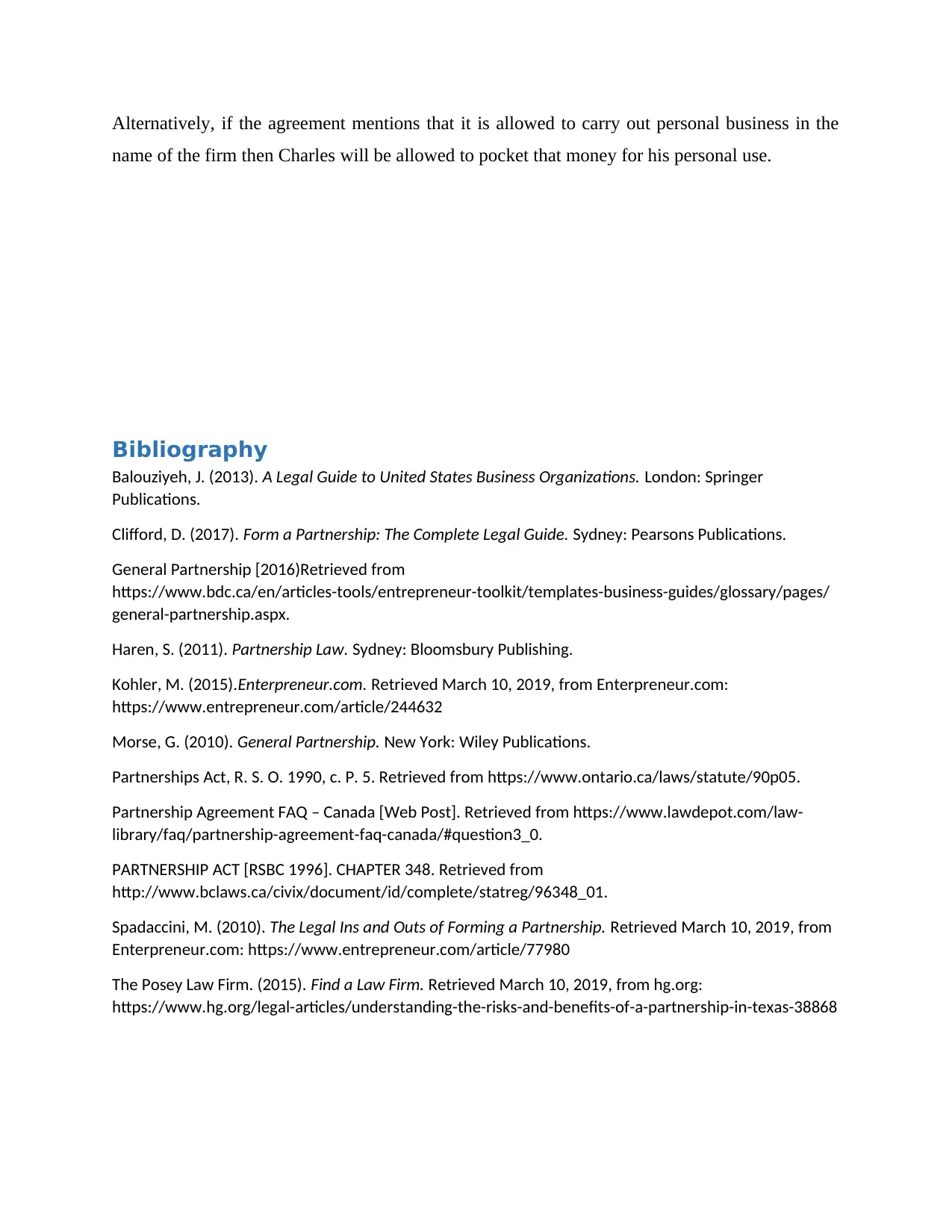
Alternatively, if the agreement mentions that it is allowed to carry out personal business in the
name of the firm then Charles will be allowed to pocket that money for his personal use.
Bibliography
Balouziyeh, J. (2013). A Legal Guide to United States Business Organizations. London: Springer
Publications.
Clifford, D. (2017). Form a Partnership: The Complete Legal Guide. Sydney: Pearsons Publications.
General Partnership [2016)Retrieved from
https://www.bdc.ca/en/articles-tools/entrepreneur-toolkit/templates-business-guides/glossary/pages/
general-partnership.aspx.
Haren, S. (2011). Partnership Law. Sydney: Bloomsbury Publishing.
Kohler, M. (2015).Enterpreneur.com. Retrieved March 10, 2019, from Enterpreneur.com:
https://www.entrepreneur.com/article/244632
Morse, G. (2010). General Partnership. New York: Wiley Publications.
Partnerships Act, R. S. O. 1990, c. P. 5. Retrieved from https://www.ontario.ca/laws/statute/90p05.
Partnership Agreement FAQ – Canada [Web Post]. Retrieved from https://www.lawdepot.com/law-
library/faq/partnership-agreement-faq-canada/#question3_0.
PARTNERSHIP ACT [RSBC 1996]. CHAPTER 348. Retrieved from
http://www.bclaws.ca/civix/document/id/complete/statreg/96348_01.
Spadaccini, M. (2010). The Legal Ins and Outs of Forming a Partnership. Retrieved March 10, 2019, from
Enterpreneur.com: https://www.entrepreneur.com/article/77980
The Posey Law Firm. (2015). Find a Law Firm. Retrieved March 10, 2019, from hg.org:
https://www.hg.org/legal-articles/understanding-the-risks-and-benefits-of-a-partnership-in-texas-38868
name of the firm then Charles will be allowed to pocket that money for his personal use.
Bibliography
Balouziyeh, J. (2013). A Legal Guide to United States Business Organizations. London: Springer
Publications.
Clifford, D. (2017). Form a Partnership: The Complete Legal Guide. Sydney: Pearsons Publications.
General Partnership [2016)Retrieved from
https://www.bdc.ca/en/articles-tools/entrepreneur-toolkit/templates-business-guides/glossary/pages/
general-partnership.aspx.
Haren, S. (2011). Partnership Law. Sydney: Bloomsbury Publishing.
Kohler, M. (2015).Enterpreneur.com. Retrieved March 10, 2019, from Enterpreneur.com:
https://www.entrepreneur.com/article/244632
Morse, G. (2010). General Partnership. New York: Wiley Publications.
Partnerships Act, R. S. O. 1990, c. P. 5. Retrieved from https://www.ontario.ca/laws/statute/90p05.
Partnership Agreement FAQ – Canada [Web Post]. Retrieved from https://www.lawdepot.com/law-
library/faq/partnership-agreement-faq-canada/#question3_0.
PARTNERSHIP ACT [RSBC 1996]. CHAPTER 348. Retrieved from
http://www.bclaws.ca/civix/document/id/complete/statreg/96348_01.
Spadaccini, M. (2010). The Legal Ins and Outs of Forming a Partnership. Retrieved March 10, 2019, from
Enterpreneur.com: https://www.entrepreneur.com/article/77980
The Posey Law Firm. (2015). Find a Law Firm. Retrieved March 10, 2019, from hg.org:
https://www.hg.org/legal-articles/understanding-the-risks-and-benefits-of-a-partnership-in-texas-38868

1 out of 6
Related Documents
Your All-in-One AI-Powered Toolkit for Academic Success.
+13062052269
info@desklib.com
Available 24*7 on WhatsApp / Email
![[object Object]](/_next/static/media/star-bottom.7253800d.svg)
Unlock your academic potential
© 2024 | Zucol Services PVT LTD | All rights reserved.





